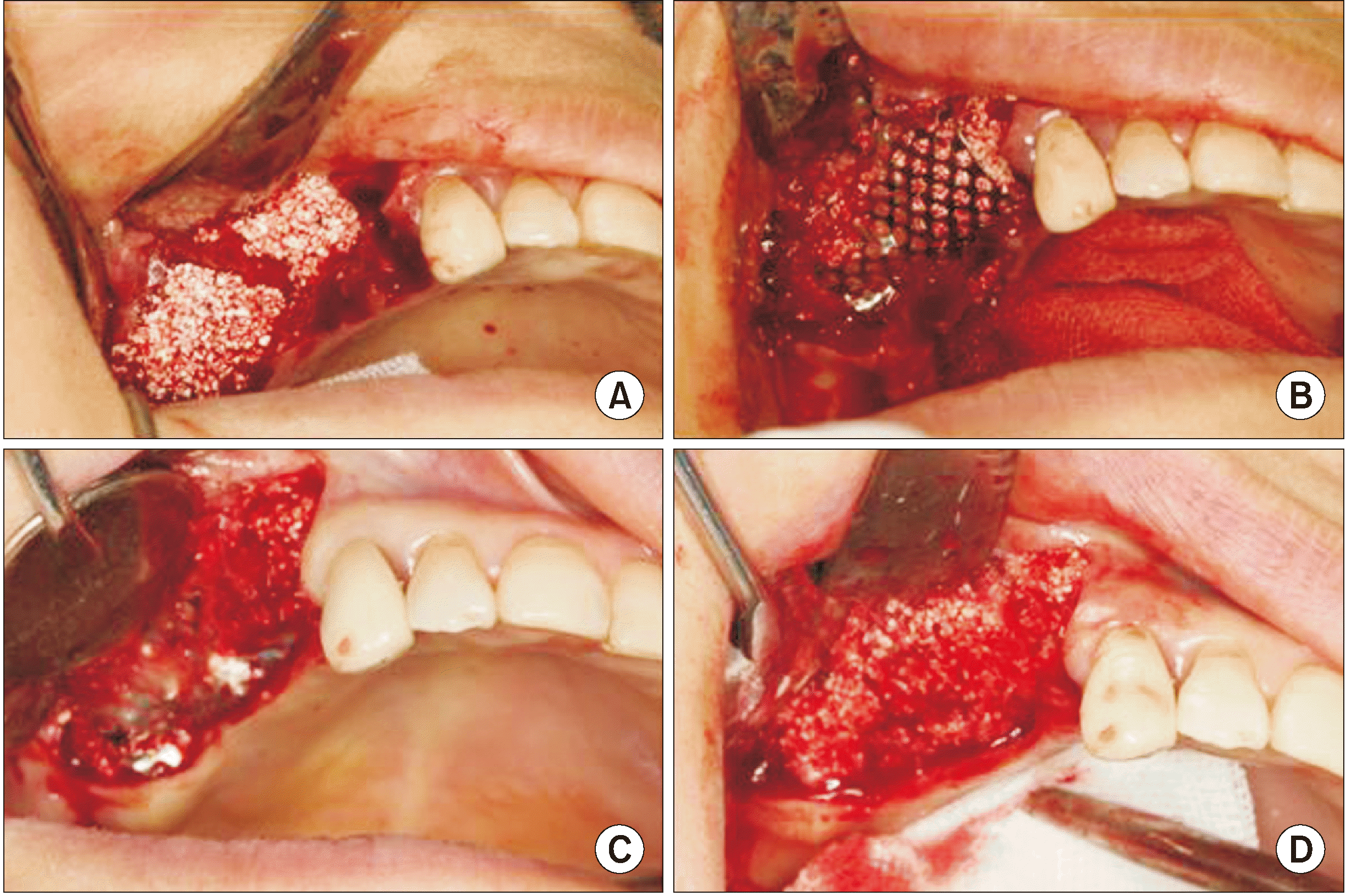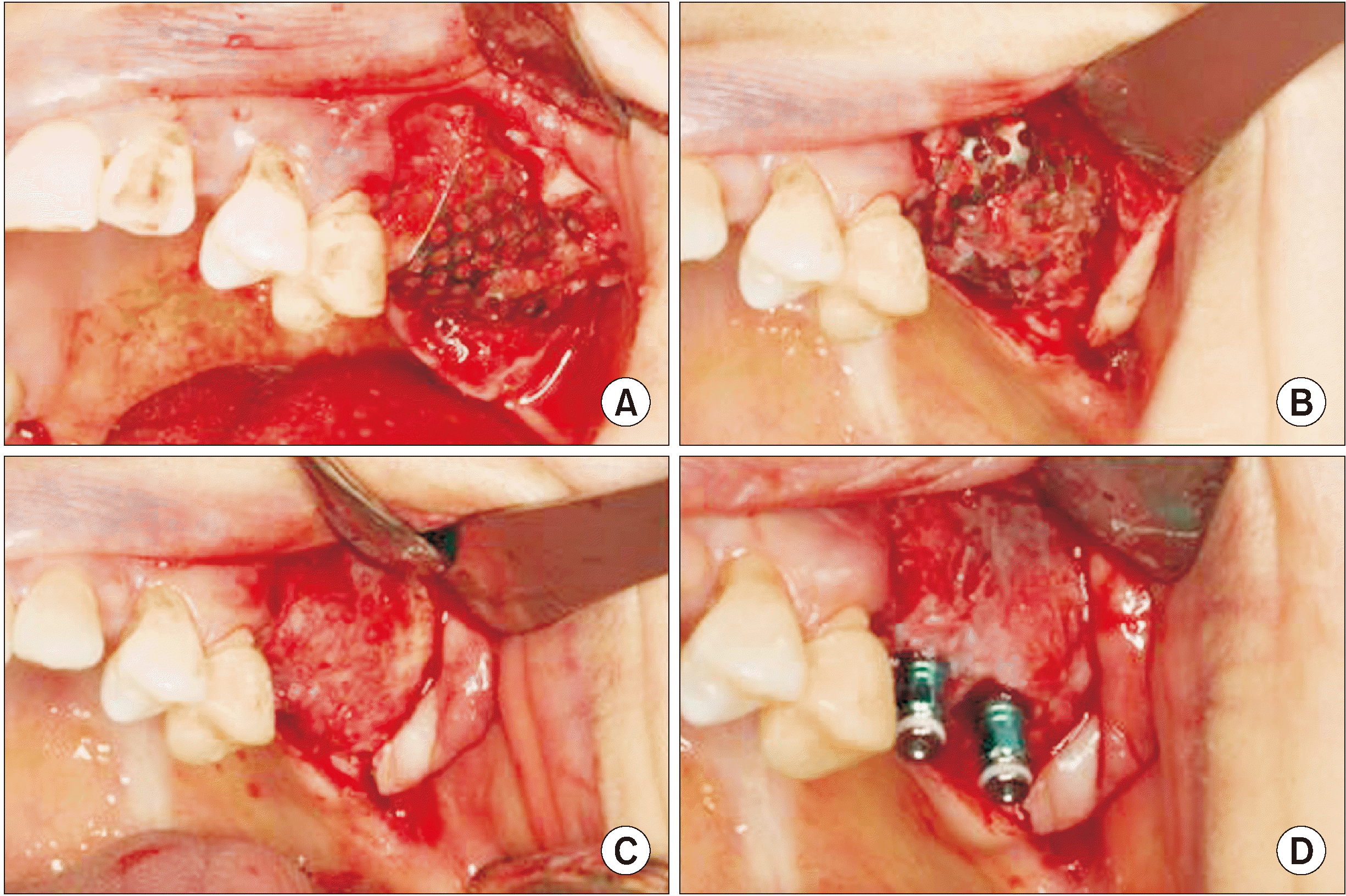1. Chiapasco M, Casentini P, Zaniboni M. 2009; Bone augmentation procedures in implant dentistry. Int J Oral Maxillofac Implants. 24(Suppl):237–59. PMID:
19885448.
2. Aghaloo TL, Moy PK. 2007; Which hard tissue augmentation techniques are the most successful in furnishing bony support for implant placement? Int J Oral Maxillofac Implants. 22(Suppl):49–70.
3. Chiapasco M, Tommasato G, Palombo D, Scarnò D, Zaniboni M, Del Fabbro M. 2018; Dental implants placed in severely atrophic jaws reconstructed with autogenous calvarium, bovine bone mineral, and collagen membranes: a 3- to 19-year retrospective follow-up study. Clin Oral Implants Res. 29:725–40. DOI:
10.1111/clr.13281. PMID:
29876968.

4. Simion M, Fontana F, Rasperini G, Maiorana C. 2007; Vertical ridge augmentation by expanded-polytetrafluoroethylene membrane and a combination of intraoral autogenous bone graft and deproteinized anorganic bovine bone (Bio Oss). Clin Oral Implants Res. 18:620–9. DOI:
10.1111/j.1600-0501.2007.01389.x. PMID:
17877463.

5. Chiapasco M, Zaniboni M, Rimondini L. 2007; Autogenous onlay bone grafts vs. alveolar distraction osteogenesis for the correction of vertically deficient edentulous ridges: a 2-4-year prospective study on humans. Clin Oral Implants Res. 18:432–40. DOI:
10.1111/j.1600-0501.2007.01351.x. PMID:
17501979.

6. Restoy-Lozano A, Dominguez-Mompell JL, Infante-Cossio P, Lara-Chao J, Espin-Galvez F, Lopez-Pizarro V. 2015; Reconstruction of mandibular vertical defects for dental implants with autogenous bone block grafts using a tunnel approach: clinical study of 50 cases. Int J Oral Maxillofac Surg. 44:1416–22. DOI:
10.1016/j.ijom.2015.05.019. PMID:
26116063.

7. Park YJ, Choi GH, Jang JR, Jung SG, Han MS, Yu MG, et al. 2009; The effect of new bone formation of onlay bone graft using various graft materials with a titanium cap on the rabbit calvarium. J Korean Assoc Maxillofac Plast Reconstr Surg. 31:469–77.
8. Roccuzzo M, Ramieri G, Bunino M, Berrone S. 2007; Autogenous bone graft alone or associated with titanium mesh for vertical alveolar ridge augmentation: a controlled clinical trial. Clin Oral Implants Res. 18:286–94. DOI:
10.1111/j.1600-0501.2006.01301.x. PMID:
17298495.

9. Draenert FG, Huetzen D, Neff A, Mueller WE. 2014; Vertical bone augmentation procedures: basics and techniques in dental implantology. J Biomed Mater Res A. 102:1605–13. DOI:
10.1002/jbm.a.34812. PMID:
23733418.

10. Schliephake H, van den Berghe P, Neukam FW. 1991; Osseointegration of titanium fixtures in onlay grafting procedures with autogenous bone and hydroxylapatite. An experimental histometric study. Clin Oral Implants Res. 2:56–61. DOI:
10.1034/j.1600-0501.1991.020202.x. PMID:
1667093.

11. Waasdorp J, Reynolds MA. 2010; Allogeneic bone onlay grafts for alveolar ridge augmentation: a systematic review. Int J Oral Maxillofac Implants. 25:525–31. PMID:
20556251.
12. Draenert FG, Kämmerer PW, Berthold M, Neff A. 2016; Complications with allogeneic, cancellous bone blocks in vertical alveolar ridge augmentation: prospective clinical case study and review of the literature. Oral Surg Oral Med Oral Pathol Oral Radiol. 122:e31–43. DOI:
10.1016/j.oooo.2016.02.018. PMID:
27236830.

14. Byun HY, Wang HL. 2008; Sandwich bone augmentation using recombinant human platelet-derived growth factor and beta-tricalcium phosphate alloplast: case report. Int J Periodontics Restorative Dent. 28:83–7. PMID:
18351206.
15. Hartlev J, Spin-Neto R, Schou S, Isidor F, Nørholt SE. 2019; Cone beam computed tomography evaluation of staged lateral ridge augmentation using platelet-rich fibrin or resorbable collagen membranes in a randomized controlled clinical trial. Clin Oral Implants Res. 30:277–84. DOI:
10.1111/clr.13413. PMID:
30715758.

16. Jeon IS, Heo MS, Han KH, Kim JH. 2013; Vertical ridge augmentation with simultaneous implant placement using β-TCP and PRP: a report of two cases. J Oral Maxillofac Surg Med Pathol. 25:226–31. DOI:
10.1016/j.ajoms.2012.05.016.

17. Molly L, Quirynen M, Michiels K, van Steenberghe D. 2006; Comparison between jaw bone augmentation by means of a stiff occlusive titanium membrane or an autologous hip graft: a retrospective clinical assessment. Clin Oral Implants Res. 17:481–7. DOI:
10.1111/j.1600-0501.2006.01286.x. PMID:
16958685.

18. Oh SH. 2008; Vertical alveolar bone augmentation using thin block and chip bone graft technique: case report. J Korean Assoc Maxillofac Plast Reconstr Surg. 30:108–13.
19. Merli M, Migani M, Esposito M. 2007; Vertical ridge augmentation with autogenous bone grafts: resorbable barriers supported by ostheosynthesis plates versus titanium-reinforced barriers. A preliminary report of a blinded, randomized controlled clinical trial. Int J Oral Maxillofac Implants. 22:373–82. PMID:
17622003.
20. Wang HL, Misch C, Neiva RF. 2004; "Sandwich" bone augmentation technique: rationale and report of pilot cases. Int J Periodontics Restorative Dent. 24:232–45. PMID:
15227771.
21. Longoni S, Sartori M, Apruzzese D, Baldoni M. 2007; Preliminary clinical and histologic evaluation of a bilateral 3-dimensional reconstruction in an atrophic mandible: a case report. Int J Oral Maxillofac Implants. 22:478–83.
22. Proussaefs P, Lozada J. 2005; The use of intraorally harvested autogenous block grafts for vertical alveolar ridge augmentation: a human study. Int J Periodontics Restorative Dent. 25:351–63. PMID:
16089043.
23. Carini F, Longoni S, Amosso E, Paleari J, Carini S, Porcaro G. 2014; Bone augmentation with TiMesh. autologous bone versus autologous bone and bone substitutes. A systematic review. Ann Stomatol (Roma). 5(Suppl 2 to No 2):27–36. PMID:
25678948. PMCID:
PMC4308965.
24. von Arx T, Buser D. 2006; Horizontal ridge augmentation using autogenous block grafts and the guided bone regeneration technique with collagen membranes: a clinical study with 42 patients. Clin Oral Implants Res. 17:359–66. DOI:
10.1111/j.1600-0501.2005.01234.x. PMID:
16907765.

25. Hellem S, Astrand P, Stenström B, Engquist B, Bengtsson M, Dahlgren S. 2003; Implant treatment in combination with lateral augmentation of the alveolar process: a 3-year prospective study. Clin Implant Dent Relat Res. 5:233–40. DOI:
10.1111/j.1708-8208.2003.tb00206.x. PMID:
15127994.

26. Schmid J, Hämmerle CH, Stich H, Lang NP. 1991; Supraplant, a novel implant system based on the principle of guided bone generation. A preliminary study in the rabbit. Clin Oral Implants Res. 2:199–202. DOI:
10.1034/j.1600-0501.1991.020407.x. PMID:
8597623.
27. Roos-Jansåker AM, Franke-Stenport V, Renvert S, Albrektsson T, Claffey N. 2002; Dog model for study of supracrestal bone apposition around partially inserted implants. Clin Oral Implants Res. 13:455–9. DOI:
10.1034/j.1600-0501.2002.130502.x. PMID:
12453120.

28. Stenport VF, Roos-Jansåker AM, Renvert S, Kuboki Y, Irwin C, Albrektsson T, et al. 2003; Failure to induce supracrestal bone growth between and around partially inserted titanium implants using bone morphogenetic protein (BMP): an experimental study in dogs. Clin Oral Implants Res. 14:219–25. DOI:
10.1034/j.1600-0501.2003.00861.x. PMID:
12656883.

29. Simion M, Dahlin C, Rocchietta I, Stavropoulos A, Sanchez R, Karring T. 2007; Vertical ridge augmentation with guided bone regeneration in association with dental implants: an experimental study in dogs. Clin Oral Implants Res. 18:86–94. DOI:
10.1111/j.1600-0501.2006.01291.x. PMID:
17224028.

30. Kloss FR, Offermanns V, Kloss-Brandstätter A. 2018; CEComparison of allogeneic and autogenous bone grafts for augmentation of alveolar ridge defects-A 12-month retrospective radiographic evaluation. Clin Oral Implants Res. 29:1163–75. DOI:
10.1111/clr.13380. PMID:
30303581. PMCID:
PMC6282851.
31. Urban I, Traxler H, Romero-Bustillos M, Farkasdi S, Bartee B, Baksa G, et al. 2018; Effectiveness of two different lingual flap advancing techniques for vertical bone augmentation in the posterior mandible: a comparative, split-mouth cadaver study. Int J Periodontics Restorative Dent. 38:35–40. DOI:
10.11607/prd.3227. PMID:
29240202.

32. Shet UK, Cho MS, Hur JW, Oh CJ, Chung K, Park HJ, et al. 2012; Evaluation of augmented alveolar bone and dental implant after autogenous onlay block bone graft. J Korean Dent Assoc. 50:329–38.
33. Oh JK, Choi BJ, Lee BS. 2009; The histologic study of bone healing after horizontal ridge augmentation using auto block bone graft. J Korean Assoc Maxillofac Plast Reconstr Surg. 31:207–15.




 PDF
PDF Citation
Citation Print
Print









 XML Download
XML Download